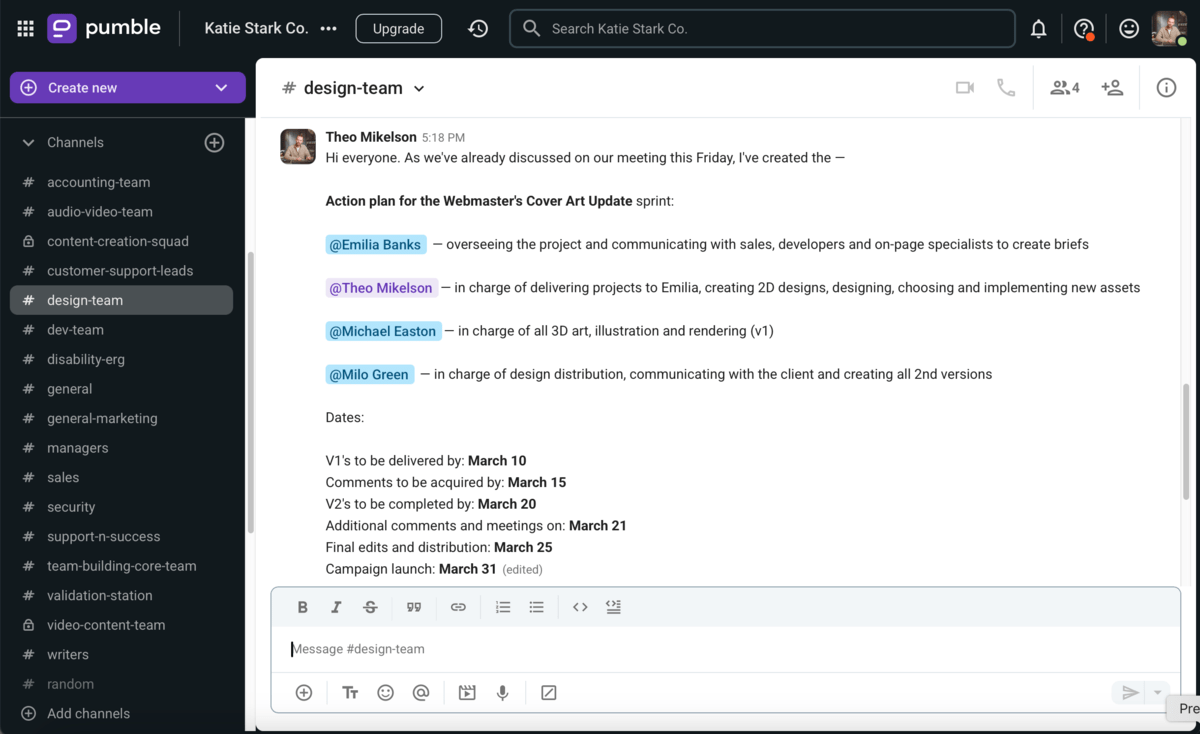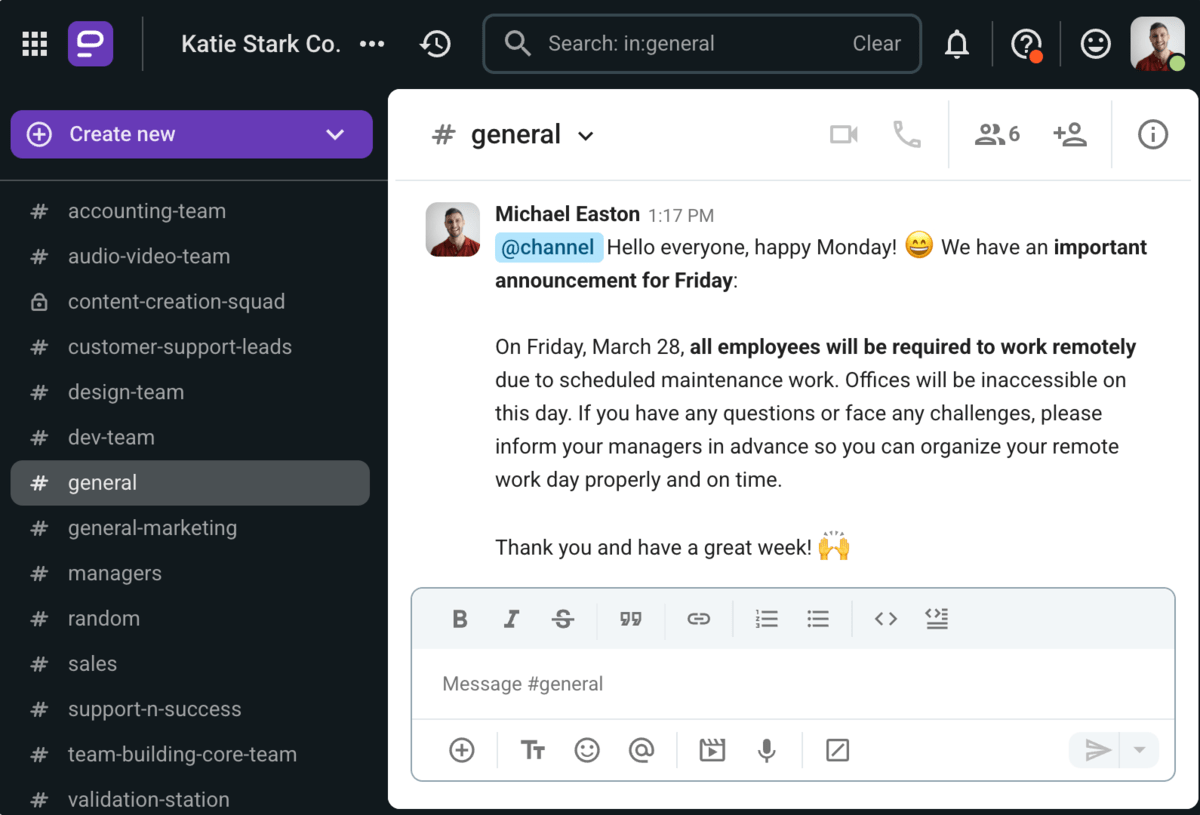Dostoevsky once said, “Much unhappiness has come into the world because of bewilderment and things left unsaid.”
However, a lack of communication can lead to much more than just unhappiness.
Although Dostoevsky (probably) didn’t have team communication in mind when he wrote his famous quote above, lack of communication or bad communication can lead to a complete team breakdown.
Team communication is important because when team members don’t communicate well throughout their joint work, they can’t successfully collaborate.
In this guide, we’ll go into the details of team communication and its importance, and cover topics such as:
- The basic definition of team communication,
- The benefits of good team communication, and
- How poor communication affects a team.
We’ll also share some expert opinions and tips on how to communicate effectively in any team.
Let’s dive in!

What is team communication?
According to the MIT Human Resources website, a team is a group “formed deliberately and carefully to meet work needs that an individual or a group of individuals cannot meet as effectively.”
Meanwhile, the same website defines teamwork as “a shared commitment both to the team’s process (how the team works together) and to its product (what work the team accomplishes).”
For teamwork to happen, individuals working in a team need to work interdependently but also come together regularly to:
- Make decisions,
- Carry out discussions,
- Plan future work, and
- Solve problems.
To be able to do that, the team needs to communicate frequently and effectively.
Team communication: Definition
Team communication represents all interactions and exchanges of information that occur in a team. This includes various:
- Types of communication (e.g. verbal communication, nonverbal communication, written communication, or visual interactions),
- Communication situations (e.g. 1-to-1 conversations, job interviews, or meetings),
- Communication styles (e.g. aggressive, passive, or assertive forms of communication),
- Communication channels (e.g. phone calls, direct messages in team communication apps, or emails), and
- Communication models (e.g. one-way, two-way, and complex two-way communication).
At its core, team communication is a transmission of information.
However, in order to have truly effective communication in a team, we have to transmit information successfully — i.e. the person sharing the information has to convey the information properly, and the person or group receiving the information has to interpret it properly.
The components of communication
In order to improve team communication, we need to thoroughly understand the communication process.
According to various theoretical frameworks, the communication process is a series of actions taken in order to successfully communicate a message. It involves 8 main components:
- The sender (initiator of communication),
- The message (a piece of information, thought or idea transferred to others),
- Encoding (process of turning a thought or idea into communication),
- Noise (anything that interferes and distorts the intended message),
- The channel (how a message travels between the sender and receiver),
- Receiver (the person who receives and interprets the message),
- Decoding (the process of understanding thoughts and ideas communicated), and
- Feedback (the receiver’s reply to the message. It answers the question of whether the message was properly encoded, sent, decoded, and interpreted).
Additionally, the message is shaped by the environment and the context in which it occurs.

How team communication influences teamwork
Team communication is a crucial element in establishing great teamwork across the workplace.
The flow of new ideas, recognition for your efforts thus far, feedback that inspires you to improve further — everything beneficial that comes from teamwork, requires constant, proper communication.
We spoke about this to Dr. Raffaello Antonino, a senior lecturer in counseling psychology, who agrees that team communication influences all aspects of teamwork.

“Think of team communication as the glue that holds the entire operation together. It directly impacts how well a team functions. Effective communication ensures the workload is shared equitably, fostering a sense of unity and common purpose. It eliminates confusion by clearly outlining everyone’s role and responsibilities, increasing productivity and focus. It’s also your most potent tool in:
- Conflict resolution,
- Diffusing tensions, and
- Promoting understanding.”
Dr. Antonino went on to add that communication also influences team dynamic on all levels:

“And let’s not forget, it’s through casual chats and shared laughs that strong bonds are formed, making the workplace a pleasant place to be. In essence, team communication is teamwork’s behind-the-scenes orchestrator, subtly but significantly influencing the team’s dynamic.”
A communications and PR expert, Jake Ciccarelli, agrees and adds that there are 3 key points of relation between communication and teamwork.

“Communication relates to teamwork in 3 key ways:
Sharing information — Communication allows the team to see if everyone is on the same page about a task or project at hand and equips all team members with the appropriate and necessary information.
Building trust with one another — Trust comes from knowing you can rely on one another when things get difficult.
Increasing productivity — Open communication makes other team members feel comfortable to communicate in your shared space. When someone is more comfortable, they will communicate any potential issues, which will facilitate higher chances of success.”
Let’s take a look at other aspects that prove the importance of team communication.
Benefits of team communication
As determined, effective business communication is of the utmost importance because teamwork relies on it.
However, teamwork has a myriad of benefits. Teamwork:
- Breeds great ideas — According to John J. Murphy, the author of “Pulling Together: 10 Rules for High-Performance Teamwork,” we may admire the “lone geniuses”, but each famous name whose inventions and skills we praise today had a team of people behind them who made it all possible to such an extent.
- Encourages healthy risk taking — Working in a team allows individuals to share responsibility with their teammates, and thus encourages them to take some healthy risks. That is beneficial both for employees (as it helps them be perceived in a more favorable light) and organizations (as it allows workers to propose new solutions to old problems).
- Makes individuals happier (and more successful) — One Atlassian research reports that honest feedback, mutual respect, and personal openness (which are all integral to great teamwork) help make the members of a team 80% more likely to report high emotional well-being and 60% more likely to achieve more and perform work faster.
- Helps teammates grow as individuals — Teamwork can help individuals understand their weaknesses and then work on improving them. Furthermore, working in a team means having a safe space to grow while being supported by other team members (through delegation, feedback, etc.)
- Decreases the chance for burnout — According to a study conducted by Edelman Data and Intelligence, 50% of employees and 53% of managers have experienced at least some level of burnout. Burnout is linked with the stress of having a lot of work to do and not enough time and resources to do it. Teamwork can alleviate this kind of stress as teams share the workload.
Aside from that, a 2021 study done on teamwork and team decision making showed that teams tend to reach conclusions through the exchange of arguments and communication, which leads to:
- Better group performance,
- Better understanding,
- Easier collaboration,
- Increased productivity,
- Improved creativity,
- Easier problem solving, and
- Lower chance for conflict.
On the other hand, poor communication will have considerable negative effects on most teams.
Consequences of poor team communication
Poor communication happens when the sender and receiver have a different take on the message. That can happen due to many reasons, but the effects are always the same — miscommunication.
In teams, this problem can occur on a 1-to-1 level of interaction among teammates, between management and employees, as well as within a team as a whole.
The effects of prolonged poor communication in teams can be grave:
- Unstable work environment,
- Lower productivity,
- Disruption in collaboration,
- Low morale,
- Workplace tension,
- Conflict,
- Poor external relationships, and
- Loss of reputation.
Let’s learn more about each consequence of miscommunication.
Consequence #1: Unstable work environment
When teams are unable to communicate effectively, they are easily overcome by the constant uncertainty and stress of not having clear objectives.
And, as mentioned before, employees who don’t know what’s expected of them are less likely to be motivated to do their tasks.
Consequence #2: Lower productivity
When there’s a breakdown in communication, team members can’t function at their optimum level. This lowers employee engagement in the team.
Given that 88% of engaged employees enjoy their work, and 50% of them thrive in their personal and professional lives, it’s clear that poor communication can directly affect their productivity.
Consequence #3: Disruptions in team collaboration
Without effective communication, team members are often left to their own devices and are unable to properly collaborate. This, in turn, shuts the door to innovation, brainstorming, and any other form of collaborative work.
Consequence #4: Low employee morale
Without proper communication, employees can feel underappreciated, which can lead to them lagging behind with work. When employees are disheartened, they are less motivated to utilize their skills for company gain.
🎓 Pumble Pro Tip
If you’re looking for a way to increase satisfaction levels and productivity in your workplace, check out our guide:
Consequence #5: Workplace tension and conflicts
In an atmosphere of uncertainty and miscommunication, tension can build up and disrupt the workflow. The most visible, and, at the same time, the most detrimental effect of poor communication is conflict among coworkers, which can harm the entire team.
🎓 Pumble Pro Tip
If you need help addressing workplace tension and arguments, check out our expert tips on:
Consequence #6: Poor external relationships and loss of reputation
Poor communication is infectious, so when team members miscommunicate, they can relay confusing and even contradictory messages to clients and other third parties.
When poor communication becomes the norm, the entire company suffers — as bad reviews pile up, the organization’s reputation takes a huge hit.
Tips for improving communication within a team
According to Pumble’s Workplace Communication Statistics, 40% of business leaders claim that poor communication decreases productivity, and 32% report having noticed the financial impact of poor communication.
That is why acquiring strong team communication skills can do wonders for you and your coworkers. But, which exact approach can you take in order to achieve effective group communication?
Let’s take a look at some applicable tips.
Tip #1: Be honest
Honesty and open communication are the cornerstones of successful teamwork.
However, people often choose to conform at work in fear of going against the current. But the truth is that inauthenticity at work can create a dissonance within a person that causes them to drift away from the rest of the team.
What’s more, when a team member expresses their disagreement with the general idea, they provide a different perspective that could benefit everyone.
For example, let’s say a member of the marketing team is the only one who notices that the slogan for a new product could be misinterpreted. If they decide to keep quiet only because everyone else agrees the slogan is great, this could seriously damage the brand.
Still, honest communication doesn’t mean you should bluntly and rudely say everything that’s on your mind.
Maintaining positive communication while being honest is of the utmost importance because it builds inter-team relationships and increases motivation and productivity (among other things).
Take a look at the Pumble exchange below. Emilia is voicing her strong opinion clearly, but despite this, she could have phrased the message more lightly — especially since she’s trying to convince a group of people who agree with each other.

Create a positive team dynamic with Pumble
🎓 Pumble Pro Tip
Being dishonest and censoring yourself in the hopes of maintaining a “social status” is one of the most common communication mistakes employees make. Find out what the other 14 are (and how to overcome them) in the following Pumble blog post:
Tip #2: Be clear and concise
One of the most important components of successful team communication is being able to convey the message clearly and precisely.
So, think before you speak, and try to get your point across as effectively as possible.
Not communicating clearly leads people to rely on assumptions when interpreting the message, which is one of the leading causes of communication breakdown.
Miscommunication, in general, leads to misunderstandings, and the latter can cause all sorts of problems within your team, such as:
- Missed deadlines,
- Errors,
- Bottlenecks in the workflow, and even
- Conflict.

Promote effective team communication with Pumble
Tip #3: Be respectful and considerate
Research about respectful communication at work, presented in a recent study, showed that people value respectful engagement more than autonomy, job security, and high income.
So, respect your teammates’ time and energy, and be careful not to overburden them. If you want to delegate a task to someone, first check if they have the time and are willing to do it. If someone is on a break and doing nothing, it doesn’t mean they are available for work.
Being considerate can also mean offering help if you see that someone is struggling or even bringing a cup of tea to a stressed-out colleague.
Seemingly little things can go a long way and truly strengthen your relationships within the team.
Tip #4: Use nonviolent communication (NVC)
Nonviolent communication is a concept created by Marshall Rosenberg, Ph.D, presented in his book Nonviolent Communication: A Language of Life. This process includes:
- Observing without judgment,
- Expressing your feelings,
- Expressing your needs, and
- Voicing your requests.
We asked Avigail Lev, psychotherapist, author, mediator, and executive coach, what she thinks the advantages of NVC are. She states that it opens up many possibilities for team communication.

“Nonviolent communication is a powerful tool that promotes win-win scenarios in problem solving. It teaches people how to focus on identifying underlying needs rather than surface-level wants, which allows us to truly understand what is important to each party involved.
When we can distinguish between wants and needs, we can engage in negotiations that are more likely to meet everyone’s core needs, cultivating a sense of satisfaction and cooperation.
This approach opens up the possibility for creative problem-solving solutions that shift our focus from rigid positions to flexible exploration of options that address the underlying needs of all parties.”
She continues that through utilizing NVC, we can reach often unattainable win-win solutions.

“When we recognize, value, and negotiate diverse needs, it enables us to find win-win scenarios that promote understanding, collaboration, and sustainable resolutions.
NVC helps us understand our own limits, boundaries, needs, and desires, resulting in more effective communication and reaching win-win solutions that benefit everyone. It also helps us develop a better understanding of ourselves, through fostering self-awareness and allowing us to connect with our own emotions and needs.
This self-awareness empowers us to communicate our thoughts and emotions more authentically and assertively.”
Tip #5: Listen attentively
Getting your message across successfully is only part of the work. Great team communication also relies on active listening. This is a skill you can practice by being attentive to what your colleagues are saying and truly understanding their points of view.
To ensure you’re doing your best to actively listen when you’re receiving a message, you can try to:
- Adjust your attitude — A positive attitude makes you more receptive to what other people have to say.
- Pay attention — Paying attention and focusing on both verbal and nonverbal cues people are sending us makes us better listeners.
- Adjust your response — Not making assumptions and being flexible when listening to what the sender of the message is trying to convey is also an important feature of active listening.
This way, you’ll not only improve your overall team communication and collaboration, but you will also show respect for the other team members and their opinions.
🎓 Pumble Pro Tip
Active listening is one of the vital skills that effective communicators have. To find out more about it, check out this Pumble Learn entry:
Tip #6: Choose the best channel for conveying your message
Effective and efficient communication also depends on the team’s smart use of different communication channels.
Choosing the right channel to contact a coworker is especially important if you’re working in a remote team and can’t simply hop to their desk and ask a question.
But even in the office, face-to-face communication is often not the best option. For example, you won’t go from person to person delegating tasks if you can do that through a project management platform. Similarly, you won’t stand up in the middle of the office to shout an announcement that you need to deliver to an entire group of people.
Instead, you’ll use a different channel — one that is a better outlet for organizational communication.
Likewise, even in one-on-one conversations, when remote workers need to consult their colleagues on a problem, it’s much more practical to discuss it in a team communication app, such as Pumble, than send emails back and forth.

🎓 Pumble Pro Tip
Maintaining communication through the proper channels is one of the best ways to make your remote team feel connected. Here are a few other tips on how you can do that:
Tip #7: Find everyone’s preferred communication styles
Aside from finding a communication channel that best fits everyone’s needs, it’s also vital that you understand every team member’s preferred communication style.
Not everyone will communicate in the same way (just like they won’t receive the same message in the same way).
We asked Ciccarelli about this and he stated that recognizing differences in communication can be the best strategy for improving communication effectiveness.

“Initiate a thorough discussion about each team member’s preferred communication style.
Recognizing that individuals may have unique preferences and challenges when it comes to communication enables the team to adapt their approaches accordingly. In particular, some team members may find it difficult to ask for help, which is why proactively offering assistance without waiting for a direct request can be an effective way to check in with them.
This proactive approach demonstrates support and fosters an environment where team members feel comfortable seeking assistance when needed.”
Tip #8: Be open to feedback and constructive criticism
No one is immune to mistakes, and we often can’t see our own errors. That’s why we should value constructive feedback coming from our colleagues, as it can help us learn, grow, and stay engaged.
Constructive criticism is just as important as employee recognition for improvement and engagement, so we should welcome both. In fact, feedback of any kind encourages engagement — ¼ of female employees and ⅕ of male employees state that providing feedback and recognition is a powerful engagement tool.
Even if you don’t agree with the feedback you receive, take it with grace and don’t get offended. Simply explain your perspective and try to find common ground. Where there’s room for feedback, there’s room for improvement.
Being open to constructive criticism means allowing your team members to prompt you to always strive to become better at what you do.
Tip #9: Address issues as they arise
When left unaddressed, even small issues tend to create frustrations that eventually lead to major problems in the team. So if something is bothering you, be sure to communicate it in a respectful, neutral tone and try to deal with it right away.
Communication in successful work teams is unobstructed and doesn’t steer away from dealing with difficult things.
You may find it hard to deal with the problem, but by addressing it right away, you clear the air and save yourself from building up resentment.

Don’t let any issues go unresolved with Pumble
Tip #10: Engage in bottom-up communication
Finally, ensure that all team members, no matter their spot in the team hierarchy, are included in the conversation. That is something that Dr. Antonino highlights as especially important for teamwork and the overall success of the team.

“Often the best ideas come from the ones on the front line, but these can be stifled by hierarchical dynamics. Encouraging communication from those at the lower rungs of the ladder to the top can be a game-changer. It’s like opening the windows and letting fresh air into your strategy planning, giving everyone a sense of ownership and responsibility.”
Dr. Antonino also urges you to remember that effective team communication isn’t a one-way street.

“Remember, this isn’t just about extracting ideas from your team. It’s also about fostering an atmosphere of trust and respect, where everyone feels their voice matters. And it goes without saying, leaders must be prepared for both constructive feedback and the occasional harsh truth. As they say, the truth can hurt, but it can also heal and pave the way for growth.”
🎓 Pumble Pro Tip
Clearly, communication is of the utmost importance. If you’re looking to further improve it, check out these two Pumble Learn entries:
Amplify internal team communication with Pumble
One of the easiest ways to improve your team’s communication is by making it simple, accessible, and effective. In today’s day and age, this is best accomplished with dedicated internal communication apps like Pumble.
Pumble offers users substantial versatility for different types of communication, including:
- Written communication through direct messages and sharing of important documents, and
- Verbal communication through voice calls, voice and video messages, and virtual meetings.
Pumble functions as your digital HQ, allowing for flexibility in how you notify your coworkers, address issues, and formulate ideas.
Furthermore, Pumble inspires you to communicate concisely and effectively, remember important processes through custom reminders, and keep track of information through threads.
Improve your team communication efforts today, and start utilizing the best communication practices intuitively. Try Pumble by CAKE.com today!
How we reviewed this post: Our writers & editors monitor the posts and update them when new information becomes available, to keep them fresh and relevant.

